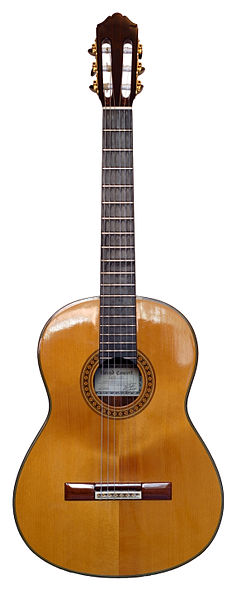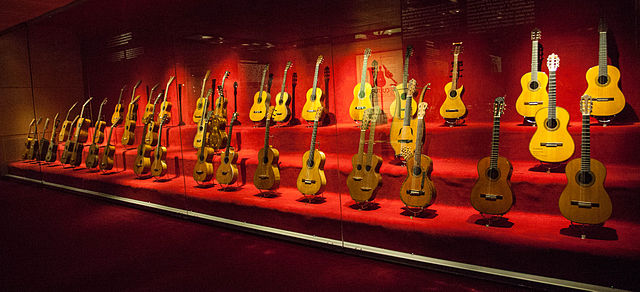An acoustic guitar is a musical instrument in the string family. When a string is plucked, its vibration is transmitted from the bridge, resonating throughout the top of the guitar. It is also transmitted to the side and back of the instrument, resonating through the air in the body, and producing sound from the sound hole. While the original, general term for this stringed instrument is guitar, the retronym 'acoustic guitar' – often used to indicate the steel stringed model – distinguishes it from an electric guitar, which relies on electronic amplification. Typically, a guitar's body is a sound box, of which the top side serves as a sound board that enhances the vibration sounds of the strings. In standard tuning the guitar's six strings are tuned (low to high) E2 A2 D3 G3 B3 E4.
Image: Classical Guitar
Image: Martin HD28
A reconstruction of a medieval gittern, the first guitar-like instrument
Basic anatomy of a classical guitar
The guitar is a stringed musical instrument that is usually fretted and typically has six or twelve strings. It is usually held flat against the player's body and played by strumming or plucking the strings with the dominant hand, while simultaneously pressing selected strings against frets with the fingers of the opposite hand. A guitar pick may also be used to strike the strings. The sound of the guitar is projected either acoustically, by means of a resonant hollow chamber on the guitar, or amplified by an electronic pickup and an amplifier.
Instrument labeled "cythara" in the Stuttgart Psalter, a Carolingian psalter from 9th century Paris.
19th-century guitar made by luthier Manuel de Soto held by Spanish guitarist Rafael Serrallet
Guitar collection in Museu de la Música de Barcelona
The Guitar Player (c. 1672), by Johannes Vermeer








